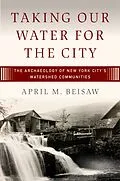Tap water enables the development of cities in locations with insufficient natural resources to support such populations. For the last 200 years, New York City has obtained water through a network of nineteen reservoirs and controlled lakes, some as far as 125-miles away. Engineering this water system required the demolition of rural communities, removal of cemeteries, and rerouting of roadways and waterways. The ruination is ongoing. This archaeological examination of the New York City watershed reveals the cultural costs of urban water systems. Urban water systems do more than reroute water from one place to another. At best, they redefine communities. At worst, they erase them.
Autorentext
April M. Beisaw is an Associate Professor of Anthropology at Vassar College in Poughkeepsie New York. Since publishing Identifying and Interpreting Animal Bones: A Manual, with Texas A&M University Press, April has focused on the archaeology of the recent past. Her work on the impacts of the New York City water system on contemporary watershed communities has appeared in the International Journal of Historical Archaeology and as a chapter within the volume Contemporary Archaeology and the City: Creativity, Ruination, and Political Action.
